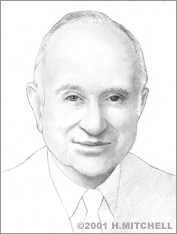Bernard Gordon
Bernard Gordon, founder, chairman, and CEO of Massachusetts-based Analogic Corporation holds more than 200 patents worldwide. A lifelong inventor, Gordon’s creations include the fetal monitor, the high-speed analog-to-digital converter, the instant imaging computer-aided tomography (CAT) scanner, Doppler radar, and an advanced bomb-detection device.
Gordon grew up during the Depression era in western Massachusetts. As a boy, he liked to fix radios and transmitters. His interest in learning how things work led to an opportunity at age 13 to earn his first dollar. He began building and selling improved outhouses featuring a cord that, when pulled, released lime and helped leach waste into the ground.
Gordon’s father demanded nothing less than excellence from his son when it came to school. During his years at Springfield Technical High School, young Gordon won science prizes, competed on the track and wrestling teams, and served as class co-president. At age 16, Gordon applied to the Massachusetts Institute of Technology (MIT), but he didn’t get in. So, he turned to the U.S. Navy's officer training program. The Navy first sent him to MIT, then to Tufts University, where he serves today as trustee and a member of the Board of Overseers for Engineering.
After serving as a Naval officer assigned to destroyer escorts, Gordon returned to MIT on the G.I. Bill, graduating with a bachelor's degree in 1948 and a master's degree in 1949, both in electrical engineering. After college, Gordon began working at the Eckert-Mauchly Computer Company (which eventually evolved into part of Unisys Corp). There, he was involved in a historic technological breakthrough, UNIVAC, the world's first commercial digital computer. The core technology of high-speed analog-to-digital conversion that Gordon and his team worked on is now found in an incredible range of electronic devices, from computers, compact discs, and televisions to EKG machines, digital thermometers, clocks, and imaging equipment.
In 1953, Gordon co-founded EPSCO, Inc., where he was involved in the development of the dot matrix display (with An Wang), fetal monitors, navigation and traffic control systems, digital Doppler radar, and a range of other pioneering technologies. In 1964, he founded Gordon Engineering, which was later recognized for its invention of the first solid-state X-ray generator. Gordon Engineering became Analogic Corporation in 1969, and the company added a variety of manufacturing capabilities in the fields of medical and industrial imaging and measurement systems.
At Analogic, Gordon established his company as a worldwide leader in areas such as ultrasonography and digital imaging, supplying the digital electronic processing subsystems for the leading laser imagers in the industry – the equipment that prints today’s black-and-white x-ray films. Analogic also invented instant imaging computed tomography (CT) scanning in 1975, making a name for itself in medical imaging subsystems. Later, the company created the world's first lightweight, mobile CT scanner, which can be operated by one person, easily moved among hospital rooms, and plugged into a standard electrical outlet.
In addition to his professional endeavors, Gordon is active in encouraging reform in engineering education. In 1984, he created the Gordon Institute at Tufts University, a graduate-level program for career engineers that provides engineers and technical professionals with the option to pursue either a one- or two-year course centered around classes and/or real-world projects.
In 1972, Gordon was elected an Institute of Electrical and Electronic Engineers Fellow and later received that organization's Engineering Leadership Recognition Award. In 1986, he was honored with the second National Medal of Technology from President Ronald Reagan. In 1992, he received the Benjamin Franklin Award for Innovation in Engineering and Technology from the Franklin Institute. He became a member of the National Academy of Engineering in 1991.
He and his wife, Sophia, founded the Gordon Institute of Engineering Leadership at Northeastern University in the early 1990s and the Bernard M. Gordon MIT Engineering Leadership Program in 2007 to train engineers and support educational and medical initiatives.


